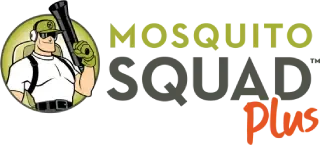New Year, New Bugs!
Posted by Mosquito Squad
January 9, 2023

Between irregular dry and wet seasons, 2022 was a surprising year for insect pressures across the United States. Another surprise we encountered last year – lots of insect invaders!
Introduced species rarely become invasive, but when they do, they often invade in full force. No matter where you live, it's likely you’ve heard of the invasive species listed below. As you prepare to take on your New Year's resolutions for 2023, here’s one to add to your list: watch out for these new and emerging invasive insects!
Brown Marmorated Stink Bug
The brown marmorated stink bug (BSMB for short) is a common nuisance insect across the United States. Though they don’t bite, sting, or scratch, they do have a tendency to find their way into your home, especially in the cooler months. Aside from their annoying nature, BMSBs also pose agricultural threats to a range of vegetation, including ornamental landscape plants, fruiting trees, and vegetables on the vine.
In 2022, stinkbugs were seemingly everywhere, and 2023 is predicted to have even higher levels of BMSB presence. According to a study published last October in Pest Management Science, the suitable habitat range for BMSBs in the U.S. is likely to increase by 70% as climates continue to change. This means brown marmorated stink bugs will be back in full force this year. Make sure you check your home for stink bug entryways!
Read more about Brown Marmorated Stink Bugs here.
Spotted Lanternfly
With their bright red, white, and black speckled appearance, and their tendency to cover trees by the hundreds, spotted lanternflies showed up and showed out this past year throughout the Mid-Atlantic. Their name is a bit deceiving as spotted lanternflies aren’t actually flies at all. Instead, these insects are members of Hemiptera, the scientific order for true bugs (the same as BMSBs!).
However, as intriguing as they look, spotted lanternflies pose a large threat to the agriculture industry throughout the U.S. Spotted lanternflies are polyphagous herbivores, a fancy way of saying they are anything but picky eaters. Experts estimate over 103 plant and tree species are suitable host plants for spotted lanternflies, the most important of which are fruiting trees like apples, plums, peaches, and cherries and fruiting vines like grapes.
By feeding on the sap from the stems, leaves, branches, and trunks of trees, spotted lanternflies leave damage marks across the plants that will secrete sap and sugars. These sticky wounds can then become moldy over time, and the sweet secretions may attract other insect pests flying by, further hurting the tree in either case.
While spotted lanternflies appeared in the highest concentrations in the Northeastern region of the United States this past year, experts warn that their populations are likely to continue spreading westward in the coming years. Keep your eyes peeled for spotted lanternflies this year!
Read more about Spotted Lanternflies here.
Region-specific invaders
North, South, East, West – in every direction you turn, there's a pest! Check below to see what invaders might be living in your neck of the woods:
Black Fig Fly – Southern California
In 2021, the black fig fly was introduced to southern California. As its name suggests, this small black fly exclusively feeds and reproduces on fig fruits. While this fly has not yet reached the Central Valley, where the majority of California’s commercial fig farmland is located, its presence still poses a threat to the state’s fig industry. California produces nearly all figs grown in the United States, and the damage caused by the fly feeding and growing in these figs can lead to premature fruit dropping or figs becoming unusable due to excess insect damage.
If you live in this region, check your fig fruits for signs of insect damage, and be on the lookout for small flies with:
- Black, glossy coloration
- Large, red eyes
- Small bodies, ~4mm long
Elm Seed Bug – Western US
Introduced in 2012 from Europe, the elm seed bug is a true invasive bug that hosts on the Siberian elm, a tree found throughout the western US. Though elm seed bugs pose no threats to human or animal health, they are often unwanted visitors in many western households. While other nuisance insects like roaches or flies typically wander in the home by themselves, elm seed bugs tend to enter households and buildings in large quantities.
You’ll know that you have an elm seed bug infestation if you see one or more:
- Dark, rusty-colored insects.
- Small insects, measuring about 1/3 inch long.
- Insects with red and black dotting along the sides of their bodies.
Emerald Ash Borer – Midwestern US
The Midwest is currently home to the emerald ash borer (EAB), an invasive beetle native to Asia. Adult EAB beetles are fully metallic green and are usually seen on the exterior of ash trees, where they nibble away at leaves. The damage on ash leaves is nothing compared to the damage EAB larvae cause to the tree from under its bark. By feeding on the phloem, the layer of tree just under the bark, EAB larvae cause damage to important nutrient and water pathways for the tree, leading to hundreds of millions of ash trees dying from EAB infestations every year.
If your state monitors for emerald ash borers, be on the lookout for the following:
- Shiny, metallic green beetles.
- Slender beetles, measuring ½ inch in length.
- Ash trees in your area with significant woodpecker damage (this might indicate an infestation has already occurred).
Red Imported Fire Ant – Southern US
Originally native to South America, red imported fire ants (RIFA) are notorious for their bites and stings. Red imported fire ants are proficient nest builders, allowing them to easily disperse throughout the southern United States. It’s difficult for even experts to tell red imported fire ants apart from native fire ant species.
The most discerning characteristic is the aggressive behavior RIFA have when something disturbs their mound. RIFA nests are built out of soil terrain and look like large mounds of loose brown or red terrain. When disturbed, ants will pour of out the mound ready to attack nearby enemies (people, pets, other insects – anything nearby is a threat!).
As fire ant mounds can be built year-round, so be sure to check your lawn for signs of red imported fire ants:
- Are ant mounds presents around your lawn?
- Do the mounds look like loosely packed soil?
- Have you seen dark red ants wandering about your yard?
To learn more about Mosquito Squad's fire ant control, click here.
While there's no shortage of backyard pests, you don't have to fend them off on your own. Contact your local Mosquito Squad today to help you take back your yard!
